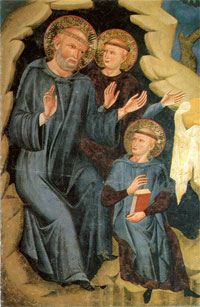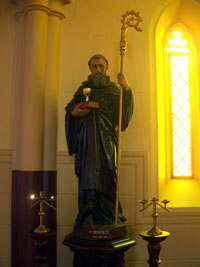St Benedict
Benedict’s Life

St Benedict with Maurus and Placidus Fresco, Subiaco, 13th century
Benedict was born into a distinguished family in the central Italian city of Nursia around 480. As a young man, he was sent to Rome to further his education. Rejecting what he saw as the corrupt and depraved environment of the city, Benedict retired first to the village of Affile, east of Rome, then to a rugged region near Subiaco, where he spent three years in solitude and prayer.
During these three years of solitude, broken only by occasional communications with the outer world, he matured both in mind and character, in knowledge of himself and of others.
Eventually, Benedict’s personal holiness attracted disciples and in time, twelve small monasteries were established around Subiaco, with Benedict as the spiritual father of them all.
Around the year 530 Benedict left Subiaco with some of his disciples for Monte Cassino, halfway between Rome and Naples, where he began a single, close-knit community on a mountain top. There he remained until his death at Nursia around the year 547. It was at Monte Cassino that Benedict completed his “Rule of Life” basing it on earlier monastic literature as well as his own original material.
The Rule is an instruction to his monks as to how they should direct all aspects of their lives towards the service and will of God. Benedict set out a rule for a balanced life of prayer, work and rest. He was mindful of the different temperaments and backgrounds among those who would live by the rule.
Saint Benedict’s monastic way of life has influenced the Catholic Church and Western civilisation profoundly in the centuries since his death. Benedictine life has been a guiding light for the church and the world in some of its difficult times.
Here at St Benedict’s Broadway, we are particularly inspired by two special characteristics Benedict encouraged in his followers: one was to “listen with the ear of the heart”, to listen deeply to how the Spirit of God was leading them in their lives; the other was to be people of hospitality, to always welcome the stranger or visitor as if he or she were Christ himself.
St Benedict’s guidance for our prayer life today

Starnina, St Benedict Santa Maria del Carmine, Florence, c.1393–1410
Since Benedict wrote his Rule some fifteen hundred years ago, we might well ask what relevance it could have for us in the twenty first century. Our lives today can often be lived at an incredible pace, where the emphasis is on outcomes and results, rather than living with mindfulness and awareness. We can live impatient lives with a focus on completion. For example, our morning prayer may suffer from the need “to finish” and get on with “the real work” of the day. How many of us really listen and savour the various parts of the Mass? Our hearing and reading of Scripture may also suffer from a desire to “get to the end” and thus ignore the fact that Scripture is from, and of, God.
Even in the sixth century, Benedict understood this problem. The opening words of the Prologue to the Rule exhort each monk to “Listen, O my son, to the precepts of thy master, and incline the ear of the heart.”
At the very heart of Benedict’s Rule is Prayer as an act of listening which requires silence and is centered on the Word of God. The words from Samuel remind us that this must be our first attitude in prayer: “Speak Lord, your servant is listening.” (1 Samuel 3.10)
For Benedict’s monks, to come together and pray the Divine Office at specific times during the day was to engage in the “work of God”. Nothing else took precedence over praying the Psalms and songs that Jesus himself would have prayed. Importantly, this was prayer that was not confined to the Chapel. For those monks unable to come to the Chapel, they joined in this prayer from wherever they were. For us today, this still holds true. No matter where we are in the world, to stop what we are doing for a time and pray the Divine Office brings us into unity with the entire Church.
Benedict also instructed his monks in the practice of lectio divina or “sacred reading”. Scripture was to be entered into deeply. In fact, much of the monks’ day was set aside for the contemplation of God’s Word for it to became part of their very being. The monastic ideal of “purity of heart” was the desire to remain in God’s Word… and God’s Word alone.
The movement of lectio divina is that we read (Lectio) under the eye of God (Meditatio) until the heart is touched (Oratio) and leaps to flame (Contemplatio) – see further explanation.
At St Benedict’s today

Statue of St Benedict St Benedict’s Church, Broadway
Our church was the first to be dedicated to St Benedict in Australia. Standing now at the beginning of the 21st century, we particularly entrust the parish and its work to him. Following his example we strive to make our parish a place where the Divine Office is cherished and celebrated, where the Word of God is prayerfully read and pondered and where all are welcomed and encouraged to listen for the still, small voice of God in their lives.